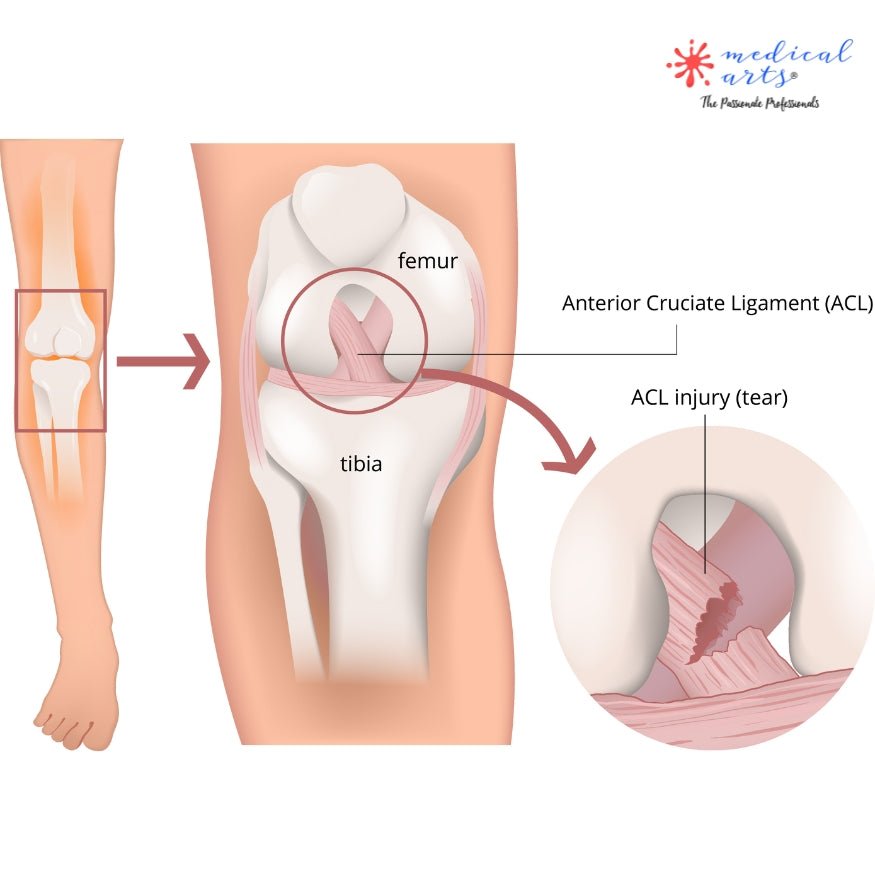ACL Rupture and Reconstruction: An Overview
Introduction:
-
Significance of the ACL: The Anterior Cruciate Ligament (ACL) is crucial for knee stability and movement.
-
Prevalence: ACL injuries are common, particularly in athletes and physically active individuals, impacting mobility and quality of life.
- Consequences: These injuries can lead to long-term knee problems and require significant treatment and recovery time.
What is an ACL Rupture?
-
Anatomy and Function: The ACL connects the thigh bone (femur) to the shin bone (tibia), vital to knee stability.
-
Causes: Ruptures often result from sports-related activities involving sudden stops, directional changes, or knee impact.
- Symptoms: Key indicators include a distinctive "popping" sound, immediate and severe knee pain, swelling within a few hours, and a feeling of instability or inability to bear weight on the knee.

Diagnosis of an ACL Injury
-
Clinical Examination: Doctors assess range of motion, tenderness, and swelling. The Lachman test is commonly used to evaluate ACL integrity.
-
Imaging Tests: MRI is the preferred method for diagnosing ACL injuries, providing detailed images of soft tissues, unlike X-rays.
- Differential Diagnosis: For accurate treatment planning, rule out other knee injuries, such as meniscus tears or ligament injuries.
Treatment Options
- Non-Surgical Management:
-
RICE Protocol: Rest, Ice, Compression, and Elevation to reduce swelling and pain.
-
Physical Therapy: Focuses on restoring knee function and improving strength and flexibility.
- Bracing: To stabilize the knee during recovery.

-
Surgical Treatment:
-
Indications: Recommended for complete ruptures, high-demand athletes, or if the knee remains unstable after non-surgical treatment.
-
Procedure: Involves reconstructing the torn ligament using a graft, either from the patient (autograft) or a donor (allograft).
-
Graft Options: Common grafts include patellar tendon, hamstring tendon, or quadriceps tendon.
- Arthroscopic Surgery: A minimally invasive technique used for most ACL reconstructions.

- Factors Influencing Treatment Choice: Age, activity level, degree of knee instability, and personal health goals are critical in deciding the treatment path.
The Reconstruction Procedure:
-
Surgical Technique: Surgeons use keyhole surgery (arthroscopy) for precision and reduced tissue damage.
-
Graft Attachment: The graft is secured in the knee joint using screws or other fixation devices to hold it in place.
-
Anesthesia: General or regional anesthesia is used during the procedure.
- Duration and Hospital Stay: The surgery lasts about 1-2 hours, with a possible short hospital stay for monitoring.
Post-Surgery Care:
-
Immediate Care: Post-operative care includes pain management, wound care, and early mobilization.
- Follow-up visits: Regular check-ups to monitor healing and graft integration.
Recovery and Rehabilitation:
-
Early Recovery: Wear a knee brace and crutches for the initial weeks.
- Rehabilitation Phases:
-
Phase 1 (0-6 weeks): Focus on reducing swelling, restoring full leg extension, and gentle exercises.
-
Phase 2 (6-12 weeks): Gradually increase exercise intensity to improve strength.
-
Phase 3 (3-6 months): Advanced strengthening and beginning of sports-specific training.
-
Phase 4 (6-12 months): Return to sports training emphasizing agility and plyometric exercises.
- Physical Therapy: Essential for restoring function, includes range-of-motion exercises, strength training, and sports-specific drills.

Preventing ACL Injuries:
-
Education: Awareness about proper techniques and the risks involved in high-intensity sports.
-
Warm-Up Routines: Incorporating dynamic warm-ups to prepare the muscles and ligaments for activity.
-
Sport-Specific Training: Tailored training and exercises for athletes to enhance knee stability.
- Proper Footwear: Using sports-appropriate footwear reduces undue knee stress.
Conclusion:
-
Advancements in Treatment: Ongoing research and technological advancements continue to improve the success rates of ACL reconstructions.
-
Quality of Life: Proper management of ACL injuries leads to a high likelihood of returning to pre-injury activity levels.
- Emphasis on Prevention and Recovery: Awareness and commitment to injury prevention and dedicated rehabilitation are critical to successful outcomes.

